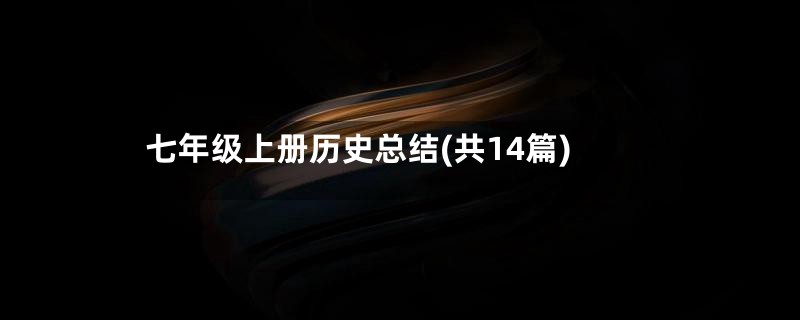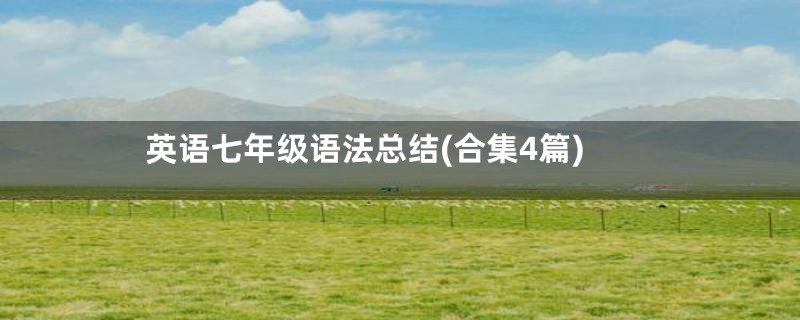七年级上册语法总结(精选5篇)
- 总结
- 2024-02-01 12:16:52
- 380
七年级上册语法总结 第1篇
一般现在时
一般现在时表示经常性或习惯性的'动作,或表示现在的特征或状态。
其动词形式是:动词原形(只有第三人称单数作主语时除外,要加-s)其疑问句和否定句需要用助动词do或does
1)肯定句用行为动词原形表示
T.他们每天早晨起来很早。
I.我一个月去看望祖父母四次。
2)否定句用don’t+动词原形来表示
WedonotgoshoppingonSundays.我们周日不去购物。
Idon’.我想你不喜欢这个颜色。
3)一般疑问句则是把助动词do提前至句首,后面动词用原形。回答时,肯定用“Yes,主语+do”;否定句用“No,主语+don’t”。
–D’clock?他们七点去上学吗?
--Yes,theydo.
--Doyoulikethisskirt?你喜欢这条裙子吗?
--No,Idon’t.不,我不喜欢。
一般现在时用来表示经常的或习惯性的动作,常与以下的时间状语连用:often经常,always总是,xxxetimes有时,usually通常,everyday/week每天/周等。
H.通常他骑车上学。
I.我每个星期都去看祖父母。
S.她总是上课迟到。
MyparentsandIxxxetimesgoouttoeat.我和父母有时出去吃饭。
Itoftenrainshere.这儿常常下雨。
主语为第三人称单数时的一般现在时
一般现在时态,当主语为第三人称单数时,谓语动词也要是第三人称单数,后要加-s或-es。
H.他喜欢夜里读书。
S.她平时骑车上学。
T.小猫每天都喝牛奶。
转换成否定句要加doesn’t,其后的动词用原形。
Kellydoesn’tgetupearlyonSaturdaysandSundays.凯丽星期六星期天起床不早。
Hedoesn’tfeelwelltoday.他今天感觉不舒服。
转换成一般疑问句,句首用Does,其后的动词用原形。
D?他在学校吃午饭吗?
D?乘火车要很长时间吗?
七年级上册语法总结 第2篇
一、重点语法
1. 动词be(am,is,are)的用法:
be动词包括“am”, “is”, “are”三种形式。
①第一人称单数(I)配合am来用。句型解析析:I am+? 例句:I am Snoopy.
I am ten years old. I am a student. I am a boy.
②第二人称(You)配合are使用。句型解析:You are+? 例句:You are my good friend.
You are a good teacher. You are beautiful ③第三人称单数(He or She or It)配合is使用。句型解析:She(He, It) is +?? 例句:She is a good girl.
She is so tall. She is short. ④人称复数 (we /you/they)配合are使用。句型解析:We (You, They) are +?? 例句 We are in Class 5,Grade 7.
They are my friends. You are good students.
用法口诀:
我(I)用am, 你(you)用are,is跟着他(he),她(she),它(it)。单数名词用is,复数名词全用are。变否定,更容易,be后not加上去。变疑问,往前提,句末问号莫丢弃。还有一条须注意,句首大写莫忘记。
对应练习:
一. 用括号中适当的词填空。
1. I ________(am, are, is) from Australia. 2. She _______ (am, are, is) a student.
3. Jane and Tom _________(am, is, are) my friends. 4. My parents _______ (am, is, are) very busy every day.
5. _______ (Are, Is, Do, Does) there a Chinese school in New York? 6. _______ (Be, Are, Were, Was) they excited when he heard the news? 7. There _____ (be) xxxe glasses on it.
8. If he _____ (be) free tomorrow, he will go with us. 一、用be 动词的适当形式填空
1. I ______ a boy. ______ you a boy? No, I _____ not.
2. The girl______ Jacks sister. 3. The dog _______ tall and fat.
4. The man with big eyes _______ a teacher. 5. ______ your brother in the classroom?
6. Where _____ your mother? She ______ at home. 7. How _______ your father?
8. Mike and Liu Tao ______ at school. 9. Whose dress ______ this? 10. Whose socks ______ they? 11. That ______ my red skirt. 12. Who ______ I?
jeans ______ on the desk. ______ a scarf for you.
15. Here ______ xxxe sweaters for you. 16. The black gloves ______ for Su Yang. 17. This pair of gloves ______ for Yang Ling. 18. The two cups of milk _____ for me. 19. Some tea ______ in the glass.
20. Gao shans shirt _______ over there.
第二课时(1)英语人称代词和物主代词
一、人称代词
表示“我”、“你”、“他”、“她”、“它”、“我们”、“你们”、“他们”的词,叫做人称代词。人称代词有人称、数和格的变化,见下表:
人称代词主格:作主语,表示谁怎么样了、干什么了。
I am a teacher. You are student. He is a student, too. We/You/They are students.
人称代词宾格作宾语,表示动作行为的对象。 Give it to me. Let’s go (let’s =let us)
二、物主代词
表示所有关系的代词叫做物主代词,也可叫做代词所有格。物主代词分形容词性物主代词和名词性物主代词二种,其人称和数的变化见下表。
形容词性物主代词(my/your/his/her/its/our/their)+名词
而名词性物主代词则相当于形容词性物主代词+名词,故其后不必加名词。如: Is this your book?
No,,it isn’t, it’s hers(her book) This pen is mine.
代词练习(一)
一、选出括号中正确的词,在正确的词上打勾。
1. This is(my / I)mother. 2. Nice to meet (your / you). 3. (He / His)name is Mark. 4. What’s(she / her)name? 5. Excuse(me / my / I). 6. Are(your / you)Miss Li? 7. (I/ My)am Ben. 8. (She / Her)is my sister. 9. Fine , thank (your / you). 10. How old is (he / his)
二、用所给代词的正确形式填空。
1. These are ______ ( he ) brothers. 2. That is _______( she ) sister. 3. Lily is _______ ( Lucy ) sister.
4. Tom, this is _____ ( me ) cousin, Mary.
5. Now _____________(her parent) are in America.
6. Those __________ ( child ) are _____ ( I ) father’s students. 7. Do you know ______ ( it ) name?
8. Mike and Tom __________ ( be ) friends. 9. Thanks for helping ________( I ).
10. ______(Ann安)mother is ______(we) teacher.
三、单项选择。
( )1. My family ____ a big family. My family ____all here.
A. is, is B. are, are C. is, are D. are, is
( )2. This is __________.
A. a picture of family B. a picture of my family
C. a family’s picture D. a family of my picture
( )3. Let’s __________ good friends.
A. be B. are C. is D. am
( )4. Is she your aunt? Yes, __________.
A. she’s B. her is C. she is D. he is
( )5. Are __________ coats yours? Yes, they are .
A. they B. these C. this D. there
( )6. Is that __________ uncle? No, it isn’t
A. he B. she C. her D. hers
( )7. Mrs. Green is __________ grandmother. A. Jim and Kate B. Jim and Kate’s
C. Jim’s and Kate’s D. Jim and Kates’
( )8. Do you know the name _____Mr. Green’s son?
A. in B. of C. on D. or
( )9. __________ the great photo of your family. A. thank for B. Thanks for
C. Thank for D. thanks for
( )10. Are those your friends? __________. A. Yes, they’re B. No, they are
C. Yes, they are D. Yes, those are
代词练习(二)
一、用适当的代词填空
1.We like ________ (he, his , him) very much. 2.Is this guitar ________ (you, your, yours)? 3.________(She, Her, Hers) name is Li Li.
4.Father bought a desk for ________ (I, my, me, mine). 5.________ (It, Its, Its) is very cold today. 6.Is this your book, Mike?
Yes ,________(we, you, they )are. 7.Are you and Tom classmates? Yes, ________(we, you ,they )are.
8.Each of the students ________( have, has) a pen pal. 9.He has a dog. I want to have ________(it, one ),too. 10.Her parents are ________ (both, all ,either )teachers.
11.The text is easy for you .There are ________( few, a few ,little,
a little) new words in it .
12.I want ________( xxxe, any) bananas. Give me these big ________
(one, ones).
二、选择正确的答案
1.Is this ________ book?
A.you B.I C.she D.your
2.Its a bird. ________ name is Polly.
A.Its B.Its C.His D.It
3.Whats that ?________ a jeep.
A.its B.Its C.Its D.its
4.Whats that in English? ________.
A.Its egg B.Thats egg C.Its a egg D.Its an egg
5.Whose cat is this ? Is it yours? Is it a white _______? A.cats B.one C.ones D.cats
七年级上册语法总结 第3篇
一. 词汇
⑴ 单词
1. 介词:in, on, under, behind, near, at, of
1). in表示;中;在内。例如:
in our class 在我们班上
in my bag 在我的书包里
in the desk 在桌子里
in the classroom 在教室里
2). on 表示;在;;上;。例如:
on the wall 在墙上
on the desk 在桌子上
on the blackboard 在黑板上
3). under表示;在;;下;。例如:
under the tree 在树下
under the chair 在椅子下
under the bed 在床下
4). behind表示;在;;后面;。例如:
behind the door 在门后
behind the tree 在树后
5). near表示;在;;附近;。例如:
near the teachers desk 在讲桌附近
near the bed 在床附近
6). at表示;在;;处;。例如:
at school 在学校
at home 在家
at the door 在门口
7). of 表示的;。例如:
a picture of our classroom 我们教室的一幅画
a map of China 一张中国地图
nbsp;
2. 冠词 a / an / the:
冠词一般位于所限定的名词前,用来署名名词所指的人或事物。冠词有不定冠词和定冠词两种。不定冠词有两个形式,即a和an。a用在以辅音音素开头的词前,如a book; an用在以元音音素开头的字母前,如an apple.
a或an与可数名词单数连用,泛指某类人或某物中的一个。
This is a cat.
这是一只猫。
It#39;s an English book.
这是一本英语书。
His father is a worker.
他的爸爸是个工人。
the既可以用在可数名词前,也可以用在不可数名词前,表示某个或某些特定的人或事物,也可以指上文提到过的人或事物。
Who#39;s the boy in the hat?
戴帽子的男孩是谁呀?
------ What can you see in the classroom?
------ I can see a bag.
------ Where#39;s the bag?
------ It#39;s on the desk.
------- 你能在教室里看到什么呀?
------ 我能看见一个书包。
------ 书包在哪呀?
------ 在桌子上。
和any
①在肯定句中用xxxexxx:
There are xxxe books on the desk.桌子上有一些书。
Lucy has xxxe good books露西有一些好书。
②在疑问句和否定句中用any。例如:
Is there any ink in your pen?你的钢笔里有墨水吗?
Do you have any brothers and sisters?你有兄弟姐妹吗?
There isn#39;t any water in the glass.杯子里没有水。
⑵记住它们的特殊用法。
①xxxe亦可用于表示盼望得到对方肯定的答复或表示建议、委婉请求的疑问句中,这一点我们不久就会学到。例如:
Would you like to have xxxe apples?你想吃苹果吗?
②any也可用于肯定句中,表示quot;任何的quot;。例如:
Any one of us can do this.我们当中任何一个都能做这个。
xxxe 和any的用法是经常出现的考点,希望大家能准确地掌握它们的用法。
family看作为一个整体时,意思是quot;家庭quot;,后面的谓语动词be用单数形式 is ;如把family看作为家庭成员时,应理解为复数,后面的谓语动词be应用are。
My family is a big family. 我的家庭是个大家庭。
My family are all at home now. 我的家人现在都在家。
Family强调由家人组成的一个集体或强调这个集体中的成员。home指个人出生、被抚养长大的环境和居住地点。 house指quot;家quot;、quot;房屋quot;,侧重居住的建筑本身。
His family are all workers. 他的家人都是工人。
My home is in Beijing. 我的家在北京。
He isn;t at home now. 他现在不在家。
It;s a picture of my family. 这是一张我全家的照片。
5. little的用法
a little dog 一只小狗,a little boy 一个小男孩。little常用来修饰有生命的名词。
_little还可表示否定意义,意为quot;少的quot;,加不可数名词。
There is little time. 几乎没时间了。
There is little water in the cup. 杯中水很少。
⑵ 词组on the desk 在桌子上
behind the chair 在椅子后
under the chair 在椅子下面
in her pencil-box 在她的铅笔盒中
near the door 在门附近
a picture of a classroom 一个教室的图片
look at the picture 看这张图片
the teacher#39;s desk 讲桌
a map of China 一张中国地图
family tree 家谱
have a seat 坐下,就坐
this way 这边走
二. 日常用语
1. Come and meet my family.
2. Go and see. I think Li Lei.
3. Glad to meet you.
4. What can you see in the picture?
I can see a clock / xxxe books.
5. Can you see an orange?
Yes, I can. / No, I can#39;t.
6. Where#39;s Shenzhen?
It#39;s near Hong Kong.
7. Let me see.(口语)让我想想看。
see 在这是quot;明白、懂了,不可译作;看见。例如:
8. Please have a seat.
seat表示quot;座位quot;,是个名词。have a seat表示quot;就坐quot;,也可以说take a seat, 和sit down的意思相同。
nbsp;
三. 语法
1. 名词所有格
名词如要表示与后面名词的所有关系,通常用名词所有格的形式,意为quot;hellip;hellip;的quot;。一般有以下几种形式:
(1). 一般情况下在词尾加quot;#39;squot;。例如:
Kate#39;s father Kate的爸爸
my mother#39;s friend 我妈妈的朋友
(2). 如果复数名词以s结尾,只;。例如:
Teachers Day 教师节
The boysgame 男孩们的游戏
(3). 如果复数名词不以s结尾,仍加;。例如:
Children Day 儿童节
Women Day 妇女节
(4). 表示两个或几个共有时,所有格应加在后一个名词上。例如:
Lucy and Lils room Lucy 和Lily的房间
Kate and Jim father Kate 和Jim的爸爸
a map of China 一幅中国地图
the name of her cat 她的猫的名字
a picture of my family 我的家庭的一张照片
the door of the bedroom 卧室的门
2. 祈使句
祈使句主要用来表示说话人的请求、命令、建议、叮嘱等意图。祈使句一般不用主语,读时用降调。为使语气委婉、礼貌,常在句首或句尾加please 。在句尾时,please前多用逗号。
(1). 祈使句肯定形式的谓语动词一律用动词原形。
Go and see. 去看看。
Come in, please. 请进。
(2). 祈使句的否定形式常用don#39;t于句首。
Don#39;t look at your books. 不要看书。
Don#39;t play on the road. 不要在马路上玩。
nbsp;
3. There be 的句子结构
There be是一个;存在;句型,表示;有的意思,
肯定句的形式为:There be + 名词(单数或复数)+地点状语或时间状语。
be动词单复数的确定,看be后边第一个名词,当所接主语为单数或不可数名词时,be动词形式为is;当所接主语为复数名词时,be动词为are;当be动词后接两个以上主语时,be动词与最临近主语保持数上的一致。意思为quot;某地有某人或某物quot;。如:
There is an eraser and two pens on the desk. 桌子上有一块橡皮和两支钢笔。
There are two pens and an eraser on the desk. 桌上有两支钢笔和一块橡皮。
(1)there be的否定句,即在be的后面加上not。
否定形式为:There be + not + (any) + 名词+地点状语。
There is not any cat in the room. 房间里没猫。
There aren#39;t any books on the desk. 桌子上没书。
(2)there be句型的疑问句就是将be提到句首:Be there + (any) +名词+地点状语?肯定回答:Yes, there is / are. 否定回答:No, there isn#39;t / aren#39;t.
---Is there a dog in the picture? 画上有一只狗吗?
---Yes, there is. 有。
---Are there any boats in the river? 河里有船吗?
---No, there aren#39;t. 没有。
nbsp;
(3)特殊疑问句:How many . . . are there (+地点状语)?quot;某地有多少人或物?quot;回答用There be . . .
There#39;s one. / There are two / three / xxxe . . .
有时直接就用数字来回答。One. / Two . . .
---How many students are there in the classroom? 教室里有多少学生?
---There#39;s only one. / There are nine. 只有一个。/有九个。
(4)如果名词是不可数名词,用:How much + 不可数名词 + is there + 地点状语?
How much water is there in the cup? 杯中有多少水?
How much food is there in the bowl? 碗里有多少食物?
七年级上册语法总结 第4篇
初中英语语法归纳:名词
初中英语学习最难的是语法,因为英语的语法跟汉语的语法有很大的不同。对于从小就生活在中国的同学们,学起英语语法来会显得特别吃力。下面为大家讲解一下初中英语名词的语法特点。
一、名词(n.) 表示人、事物或抽象概念的名称的词
(一)名词的分类
名词分为普通名词和专有名词,其中普通名词包括可数名词和不可数名词,可数名词可用作单数,也可用作复数。
可数名词包括个体名词(表示一类人或物的个体。如:boy,desk,cat,window)和集体名词(由若干
个体组成的集合体。如:family,class,police)。
不可数名词包括物质名词(表示无法分为个体的实物。如:water,paper,silk,money)和抽象名词(表示性质、行为、状态、感情或其它抽象概念。如:work,happiness,music,difficulty,housework)
专有名词表示个人、地方、机构、组织等。如:Tom,the Great Wall,the Spring Festival,France,the United States)
(二)名词的数
1.可数名词有单数和复数两种形式,其复数形式的构成主要有以下几种:
(1)一般情况下,在词尾加s.
——books,dog——dogs,pen——pens,boy——boys
以轻辅音结尾的名词后的s的读音为[s],以浊辅音和元音结尾名词后的s读音为〔z〕。
(2)以s,x,ch,sh结尾的词名词变复数时,要在词尾加es.
——beaches,brush——brushes,bus——buses,box—boxes(es读音为〔iz〕
(3)以―辅音字母+y‖结尾的名词,先变y为i,再加es.
——cities,family——families,documentary——documentaries,country——countries,
strawberry——strawberries(ies读音为[iz])
(注:以―元音字母+y‖结尾的词,直接在词尾加)
(4)以o结尾的名词,变复数时情况如下:
①,.tomato—tomatoes,potato—potatoes, hero—heroes negro ——negroes mongo——mongoesp
②结尾是两个元音字母的加s,—zoos,radio——radios ③某些外来词变复数时词尾加s,eg. piano—pianos
④一些名词的缩写形式变复数时,词尾加s,
(photograph)——photos,kilo(kilogram)kilos
⑤zero变复数时,既可加s,也可加
(5)以f或fe结尾的名词变复数时,先把f或fe变为v,再加es.
——wives,leaf leaves,half——halves,knife—knives,thief——thieves(res读音为[vz]
(注意:roof的复数为roofs; scarf的复数为scarfs/scarves)
(6)有些名词由单数变复数时,不是在词尾加s或es,而是变换其中的字
——men,woman——women,policeman——policemen,Englishman——Englishmen,Frenchman——Frenchmen, foot——feet, tooth——teeth,
child——children,mouse—mice,Ox—Oxen(公牛)
(7)还有一些名词的单数和复数形式相同。
(8)另一些名词本身即是复数形式,不可用作单数。
eg,people,police,trousers,pants,clothes,scissors
另外,①当一个名词作定语说明另一个名词时,这个名词一般用单数。
apple tree,five apple trees,a girl friend,two girl friends,a twin sister 但是,当man和woman作定语修饰复数名词时,就要用其复数形式。
men teachers,three women doctors
②可用―量词+of+名词复数‖这一结构表示可数名词的数量。
room Of students,two boxes Of pencils
2.不可数名词一般没有复数形式,它的―量‖的表示方式如下。
(1)表不定数量时,一般用much,(a)little,a lot of/lots of,xxxe,any等词修饰。 eg,much money,a little bread
(2)表确定数量时,一般用―数词+量词+of+不可数名词。如:two/three/…+量词复数十of+不可数名词。
bag Of rice,two glasses Of milk,four bottles Of water
3.有些名词既可作可数名词也可作不可数名词,但词义有所不同。
eg: fruit水果——fruits表示不同种类的水果;food食物——foods各种食品;fish鱼——fishes鱼的种类;drink饮料、酒——a drink一杯/一份饮料、一杯酒; cloth布——,a cloth桌布、抹布; sand沙——sands沙滩; tea茶——a tea一杯茶;chicken鸡肉——a chicken小鸡;orange橘汁——an orange橘子; glass玻璃——a glass玻璃杯,glasses眼镜; paper纸——a paper试卷、论文;wood木头——a wood小森林;room空间、余地——a room房间
(三)名词的所有格(表示人或物的所属关系)
(1)有生命的名词所有格以及表示时间、距离、城镇、国家等的名词所有格。 ①不是以s结尾的名词变成所有格时,在词尾加’s.
’s watch;Women’s Day
②以s结尾的名词变成所有格时,只加’。
’office,students’rooms
③两个或两个以上名词并列,表示共同所有,只需在最后一个名词后加’s.
and Mike’s room汤姆和迈克的房间(表示汤姆和迈克共有一间房) ④两个或两个以上名词并列,表示分别所有,需在几个名词后都加’s.
’s and Jenny’s bikes玛丽和xxx的自行车(表示玛丽和xxx各自的自行车)
(2)无生命的事物的名词所有格常用of结构
map Of China,the beginning Of this game,the door Of the room
(3)特殊形式
①可用’s和of短语表示的名词所有格
boy’s name=the name Of the boy(男孩的名字)
the dog’s legs=the legs of the dog(狗的腿)
China’s population=the population Of China(中国的人口)
China’s capital=the capital of China(中国的首都)
②双重所有格
fiend of my mother’s我妈妈的一个朋友
a picture of Tom’s汤姆的一张图片
初中英语语法名词的知识点总结,希望对于同学们的英语学习有所帮助和裨益,祝大家的学习越来越好!
初中英语语法归纳:连词
初中英语学习最难的是语法,因为英语的语法跟汉语的语法有很大的不同。初中英语连词有很多种。下面为大家讲解一下初中英语连词的用法。
连词是一种虚词,它不能独立担任句子成分而只起连接词与词,短语与短语以及句与句的作用。连词主要可分为两类:并列连词和从属连词。
第一类表示并列关系的连词
并列连词:并列连词用来连接平行的词、词组和分句。
1) and 和
判断改错:
(错) They sat down and talk about xxxething.
(错) They started to dance and sang.
(错) I saw two men sitting behind and whisper there.
(对) They sat down and talked about xxxething.
(对) They started to dance and sing.
(对)I saw two men sitting behind and whispering there.
解析:
第一句: and 连接两个并列的谓语,所以 talk 应改为 talked。
第二句:and 连接两个并列的动词不定式,第二个不定式往往省略to,因此sang 应改为 sing。
第三句:and 连接感观动词saw 后面的用作的宾补的两个并列分词结构,因此whisper应改为whispering。
注意:1. and 还可以和祈使句或名词词组连用表示条件。(or也有此用法) Make up your mind, and youll get the chance.
= If you make up your mind, youll get the chance.
One more effort, and youll succeed.
= If you make one more effort, youll succeed
2, A and B 当表示整体或者指同一人时谓语动词用单数, 当and连接的单数名词前分别有each,every,many等词修饰时,谓语也用单数。
bread and butter a knife and fork
The mother and teacher is very strict with her son.
No teacher and no student is allowed to smoke in class.
3. and连接的是两个相同意思的词,表示―渐渐‖,或加强语气
Read it again and again
2) both …and 两者都
She plays (both) the piano and the guitar.
3) neither…nor 意思为“既不……也不……”谓语动词采用就近原则,与nor后的词保持一致。
Neither you nor he is to blame.
4) not only…but (also)不但······而且······
She plays not only the piano, but (also) the guitar.
注意: not only… but also 关联两个分句时,一个分句因有否定词not 而必须倒装。 Not only does he like reading stories, but also he can even write xxxe.
5) as well as 以及,也,与···同样
The teacher, as well as the students, is interested in the activity.
比较and和or
1) 并列结构中,or通常用于否定句,and用于肯定句。
2) 但有时and 也可用于否定句。请注意其不同特点:
There is no air or water in the moon.
There is no air and no water on the moon.
在否定中并列结构用or 连接,但含有两个否定词的句子实际被看作是肯定结构,因此要用and。
第二类表示选择关系的连词
1) or 意思为“或则”。
Which do you prefer, tea, coffee, or juice ?
2) either…or 意思为“或者……或者 ……”。注意谓语动词采用就近原则。 Either you or I am right.
3) or else/ otherwise 否则
Be silent, or else you will be kicked out.
I am tired, otherwise, I would play.
第三类表示转折或对比关系的连词
1) but 但是 He is rich but unhappy.
while 然而,表示对比意味 Some people love cats, while others hate them. yet 然而 She said she would be late, yet she arrived on time.
however 然而,可是,不过 She does not like him, however, I like him.
2) not…but… 意思为“不是 ……而是……”
not 和but 后面的用词要遵循一致原则。
They were not the bones of an animal, but (the bones) of a human being. 第四类表因果关系的连词
1) for 因为,做并列连词使用时,是在对先行的句子补述原因或者理由,只可以连接句子与句子,通常不置于句首。
He is absent today, for he is ill.
2) so, therefore 因此
He hurt his leg, so he couldnt play in the game.
I think, therefore I am
3)then 那么,因而
Hide behind the wall, then they won’t see you.
七年级上册语法总结 第5篇
Unit 1 Where’s your pen pal from?
一、词组
be from= come form 来自...
pen pal=pen friend 笔友
like and dislike 好恶;爱憎
live in….在...居住
speak English 讲英语
play sports 做体育运动
a little French 一些法语
go to the movies 去看电影
an action movie 一部动作片
on weekends 在周末
Excuse me 对不起,打扰
get to 到达、抵达
beginning of 在...开始的时候
at the end of 在...结束的时候
arrive at /
二、句型
(1)、Where主 +be+主语+from?
主语+be+from+地点.
(2)、Where do/does+主语+live?
主语+live/lives in…
(3)、What language do/does +主语+speak?
主语+speak/speaks….
(4)、主语+like/likes+doing…
三、日常交际用语
1-Where is your pen pal from?
-He’s from China.
2-Where does she live?
--She lives in Tokyo.
3-Does she speak English?
-Yes,she does/No,she dosen’t.
4-Is that your new pen pal?
-Yes,he is /No,he isn’t.
5-What language does she speak?
-She speaks English.
Unit 2 Where’s the post office
一、词组
post office 邮局
pay phone 投币式公用电话
next to 在...隔壁
across from 在...对面
in front of 在...前面
between…and… 在...和...之间
on a street 在街上
in the neighborhood 在附近
on the right/left 在右边/在左边
on one’s right/left 在某人的右边/左边
turn right/left 向右/左转
take a walk 散步
have fun 玩得开心
the way to …去...的路
take a taxi 打的/乘出租车
go down(along)…沿着...走
go through...穿过...
have a good trip 旅途愉快
二、句型
(1)、Is there a bank near here?
Yes,there is .It’s on Centre Street.
No,there isn’t.
(2)、Where’s the sumpermarket?
It’s next to the library.
(3)、Bridge Street is a good place to have fun.
(4)、I hope you have a good trip.
(5)、If you are hungry,you can buy food in the restaurant.
(6)、Talk a walk though the park..
(7)、enjoy后接名词或动词-ing形式.
Do you enoy(=like) your work?
Do you enjoy(=like) living in the city?
三、日常交际用语
(1)、Is there a ….?句型Eg:
-Excuse there a hotel in the neighborhood.
-Yes, there is. isn’t
(2)、Where is …?句型Eg:
-Where is the park,please?
-It’s behind the bank.(肯定回答)
-I’m sorry I don’t know. (否定回答)
(3)、Which is the way to +地点? 句型xxx:
- Which is the way to the library.
(4)、How can I get to +地点?句型xxx:
-How can I get to the restaurant?
(5)、Can you tell me the way to +地点?句型.例
- Can you tell me the way to the post office?
(6)、Let me tell you the way to my house.
(7)、Just go straight and turn left.
Unit 3 Why do you like koalas?
一、词组
want to do sth .想要xxx事
want sb to do sth 想要某xxx事
want sth 想要某物
Let sb do sth 让某人xxx事
kind of 有几分\\种类
a kind of 一种…
…years old …年龄 如:ten years old 十岁
like to do sth 喜欢xxx事
like doing sth
play with … 与...一起玩
be quiet 安静
during the day 在白天
at night 在夜间
have a look at.. 看...
one…the other 一个...另一个...
二、句型
(1)、-why do you like pandas?
-Because they’re very cure.
(2)、-Why dose he like koalas?
-Because they are kind of interesting.
(3)、-Where are lions from?
-Lions are from South Africa.
(4)、-What animals do you like?
-I like elephants.
三、日常交际用语
(1)、-Let’s see the lions.
(2)-Why do you want to see the lions?
-Becase they are very cute.
(3)-Do you like giraffes?
Yes,I do./ No,I don’t
(4)-What other animal do you like?
_I like
other+ 名词的复数.表示没有特定的数量范围
the other+名词的复数表示有特定的数量范围.
(5)-Why are you looking at me?
-Because you are very cute.
(6)-Let us play games. –Great!
Let me see.
Unit 4 I want to be an actor.
一、词组
want to be+职业 想要成为。。。
shop assistant 店员
bank clerk 银行职员
work with 与。。。一起工作
work hard 努力工作
work for 为。。。而工作
work as 作为。。而工作
get.. from…从。。。获得。。。
give / 把某物给某人
正确的表示:give it/them to sb.
错误的表示:give
in the day 在白天
at night 在夜间
talk to /with 与…讲话
go out to dinners 外出吃饭
in a hospital 在医院
newspaper reporter 报社记者
movie actor 电影演员
二、句型
(1)-What do/does+某人+do?
例:-What do you do?-I’m a student.
-What dose he do? He’s a teacher.
(2)-What do/does+某人+want to be?
例:What do you want to be?-I want to be a teacher.
-What does she want to be ?She want to be a nuser.
(3)-Where does your sister work?
-She works in a hospital.
(4)-Does he work in the hospiat
does/No,he doesn’t
(5)-Does she work late?
-Yes,she does/ doesn’t
(6)-英语中询问职业的几种表达方式:
What do/does …do?
What is…? What is your father?
What’s one’s job?例:What’s your father’s job?
Unit 5 I’m watching TV.
一、词组
do homework 做家庭作业
watch TV 看电视
eat dinner 吃饭;就餐
clean the room 打扫房间
read newspaper/a book 看报纸/看书
go to the movies 看电影
write a letter 写信
wait for 等待;等候
talk about 谈论。。。。
play basketball/soccer/ 打篮球/踢足球
take photos 拍照
TV show 电视节目
Some of。。。 。。。中的一些
a photo of my family 我的家庭照
at school 在学校
be with 和。。。一起
in the tree 在树上
二、句型
(1)-What+be+主语+doing? ….正在做什么?
-主语+be+doing。。。 …正在xxx事。
例: -what are you doing?
-I’m doing my homework.
(2)-Thanks for … 为。。。而感谢
例:Thanks for your letter.
(3)-Here are/is…
例:Here are xxxe of my photos.
Here is a photo of my family.
(4)-That sounds good.
(5)-This TV show is boring.
三、日常交际用语
(1)-Do you want to go to the movices? –Sure.
(2)-When do you want to go? –Let’s go at seven.
(3)-Where do people play basketball? –At school.
(4)-What’s he waiting for?-He’s waiting for a bus.
(5)-What’s he reading? He’s reading a newspaper.
1)现在在进行时的形式是:
助动词be(am,is,are)+动词-ing形式(也叫现在分词),表示现在(说话的瞬间)正在进行或发生的动作。
2)现在进行时的肯定句形式
主语+be(am,is,are)+动词现在分词+其他
I’m watching TV.
3)现在进行时的否定句形式
主语+be(am,is,are)+not+动词现在分词+其他
They are not playing soccer.
4)现在进行时的一般疑问句形式及回答:
Is(am,are)+主语+动词现在分词+其他?
Yes,主语+is/am/are. No,主语+isn’t/aren’t/am not.
Are you reading? Yes,I am. No,I am not.
5) 现在进行时的特殊疑问句形式:
特殊疑问词+is/am/are+主语+现在分词+其他?
例:What is your brother doing?
6) 动词+ing形式(现在分词)的构成.
1一般情况下在动词词结尾加-ing.
如: eat--eating, do—doing,clean—cleaning,
play—playing,
2以不发音的元音字母e结尾的动词,先去掉e再加-ing.
如:take--taking,write—writing,have-having
come—
3词尾如果是以一个辅音字母结尾的重读闭音节词.应该先双写这个辅音字母,再加-ing.
如:run—runing,sit—sitting ,swim—swimming.
Shop——putting,sit—sitting
本文由admin于2024-02-01发表在叁佰资料网,如有疑问,请联系我们。
本文链接:http://www.sanbaiyy.com/p/12689.html
上一篇
校园艺术节活动总结(合集36篇)
下一篇
银行反洗钱宣传总结(11篇)











